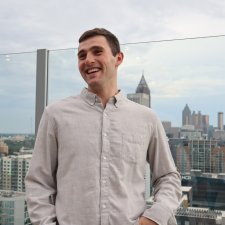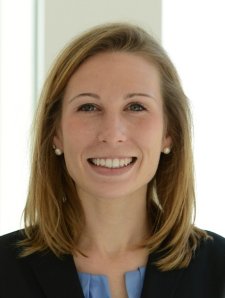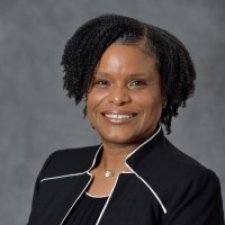Open to the public, our speaker series is designed for students and community members to hear from professionals on topics that broaden attendees’ understanding of the world and add depth to experiences. It is also an opportunity for our alumni and community members to engage with our students, potential future employees.
Spring 2026 Speakers
Jacob Moeckler
Founder, Coach Jacob LLC

"Bridging the Gap Between College and Career"
Friday, Feb. 20
1 p.m., Parkview Room (D-132), Floyd Hall
About this talk: Many students graduate with strong technical knowledge but feel unprepared for the realities of the professional workplace. This session explores the gap between classroom learning and real-world expectations, highlighting the skills, behaviors, and professional mindset that employers value most. Through practical insights and relatable examples, students will gain a clearer picture of what it takes to transition successfully from college to career. The goal is to help attendees enter the workforce with greater confidence, adaptability, and readiness to make an impact from day one.
About Moeckler: Jacob Moeckler partners with universities and companies across the country to help them better prepare students for the realities of the professional world. He focuses on closing the gap between what students learn in the classroom and the skills required to succeed in the workforce. Based in Atlanta, Jacob balances life as an engineer at a large corporation with building a startup dedicated to enhancing the early career experience.
Dr. Elaine Petro
Assistant Professor, Cornell University

"Multiscale Modeling of Electrospray Ion Beams and Beam-Surface Interactions"
Tuesday, Feb. 24
2:30 p.m., Room D-204, Floyd Hall
About this talk: Electrospray thrusters are some of the smallest and highest efficiency propulsion systems being developed for satellites. Their novel propellants and operational mechanisms motivate a deeper understanding of the physics of an expanding molecular ion beam and the chemistry of plume particle collisions. Electrospray ion plumes challenge state of the art plasma modeling techniques due to the wide range of length and timescales over which key processes take place (i.e. nanometer-scale emission sites and centimeter scale operational volumes). Accompanying these spatial gradients are large density and velocity gradients in both the ion and neutral populations. We present state of the art numerical models of the dynamics and chemistry of an expanding molecular ion plume which are necessary explore design variables, to understand operating conditions, and to improve performance. We will also discuss comparison of these models with experimental data.
About Dr. Petro: Dr. Elaine Petro is an Assistant Professor at the Sibley School of Mechanical and Aerospace Engineering at Cornell University. She is the director of ASTRAlab, a research lab focused on sustainable space propulsion and exploration architectures. Elaine completed her Ph.D. at the University of Maryland in the Space Power and Propulsion Laboratory, studying water plasma chemistry in RF discharges. She also spent several years in the MIT Department of Aeronautics and Astronautics as a visiting student and post-doctoral researcher, studying electrospray thruster technology for small satellite platforms using both numerical modeling and experimental characterization. For her work on electrospray model development, Petro is the recipient of the 2023 Air Force of Scientific Research Young Investigator Program (YIP) award. Petro has been named an ARCS Scholar, National Science Foundation and Amelia Earhart fellow, and was recognized as one of Aviation Week & Space Technology’s Twenty20s emerging leaders in aerospace in 2016. Prior to graduate studies at UMD, Petro worked on the MAVEN Mars Orbiter, and James Webb Space Telescope and Hubble Space Telescope missions at NASA’s Goddard Space Flight Center. Elaine is passionate about diversity and inclusion in STEM and is a founding member of the national Women of Aeronautics and Astronautics organization.
Dr. Elena A. Rozhkova
Staff Scientist and Principal Investigator, Center for Nanoscale Materials, Argonne National Laboratory

“Reprogramming Natural Light-Driven Mechanisms with Inorganic Nanostructures”
Thursday, March 26
11 a.m., Parkview Room (D-132), Floyd Hall
About this talk: Nanomaterials provide unique opportunities to design functional systems through size-, interface-, and structure-dependent properties. When inorganic nanostructures are combined with soft biological components, hybrid architectures can emerge that provide functionalities unavailable in either of these systems individually. In this talk, Rozhkova will discuss how inorganic nanostructures can be used to reprogram natural light-dependent mechanisms by coupling them with evolutionarily optimized biological photo-processes. In particular, Rozhkova will focus on opsins - light-sensitive transmembrane proteins that convert optical excitation into directed ion transport, considering them as modular biological elements for nanohybrid architectures. Using purple membranes isolated from Halobacterium salinarum, which contain the proton pump bacteriorhodopsin (bR), bio-inspired hybrid systems are constructed that redirect native photochemical pathways toward abiotic chemical transformations. These architectures enable light-driven nitrogen-to-ammonia (N₂→NH₃) conversion, carbon dioxide (CO₂) reduction to carbon monoxide (CO) and methane (CH₄), and glycerol oxidation to value-added products under ambient conditions. Coupling the bR photocycle with plasmonic silver and gold nanoparticles (NPs) further allows the construction of an artificial cell capable of light-driven ATP synthesis, demonstrating how inorganic components can reprogram biological energy transduction. Finally, Rozhkova will describe an alternative strategy in which radioluminescent nanoparticles convert X-ray radiation into localized optical radiation in the brain, thereby providing wireless optogenetic modulation without the need for optical fiber implantation. Together, these examples demonstrate how inorganic nanostructures can be used to reprogram natural light-driven energy conversion mechanisms, as well as to develop new approaches to optogenetic control in the brain.
About Dr. Rozhkova: Dr. Elena A. Rozhkova, is a staff scientist and principal investigator at the Center for Nanoscale Materials, Argonne National Laboratory, a U.S. Department of Energy Nanoscale Science Research Center. Her research focuses on engineered nano–bio hybrid architectures that integrate functional nanomaterials with biological components to enable light-driven energy conversion, photocatalysis and remote modulation of chemical and biological processes. Her recent work includes bio-inspired systems for artificial photosynthesis, CO₂ conversion to value-added chemicals and abiotic nitrogen-to-ammonia conversion under ambient conditions. She served as an IEEE Nanotechnology Council Distinguished Lecturer (2021–2022). She previously held research appointments as a JSPS Postdoctoral Fellow at Tohoku University (Japan), followed by positions at Princeton University (Department of Chemistry) and the University of Chicago, before joining Argonne National Laboratory in 2007.
Dr. Shanelle Foster
Associate Professor, Michigan State University

“The Benefits of Additive Manufacturing for Development of the Next Generation Electric Machines”
Wednesday, April 15
1 p.m., Parkview Room (D-132), Floyd Hall
About this talk: We’ve all heard the buzz: “Additive manufacturing (3D printing) is redefining what’s possible – delivering lightweight, customized parts with intricate designs that traditional methods could never achieve.” These technologies are often cited as key drivers of the Fourth Industrial Revolution. Recent advancements have expanded material options and opened doors to applications in medical, aerospace, and automotive industries. But are we truly on the brink of a paradigm shift – moving from the question of “what can be manufactured” to “what can be imagined and validated”?
In this talk, we will examine the benefits and limitations of various additive manufacturing technologies. The wide range of materials used in electrical machine manufacturing offers an ideal lens to assess the current state of additive manufacturing and its potential for widespread adoption. For critical applications involving magnetic and conductive materials, understanding goes far beyond microstructural properties. We will explore why it is essential for electrical engineers to study these capabilities now – so that additive manufacturing evolves to deliver meaningful societal benefits in the future. This presentation will include insights from past and ongoing research conducted in the Michigan State University Electrical Machines and Power Electronics Research (EMPowER) Laboratory.
About Dr. Petro: Dr. Shanelle N. Foster (Senior Member, IEEE) received B.S., M.S., and Ph.D. degrees in electrical engineering from Michigan State University. She is currently an Associate Professor in the Department of Electrical and Computer Engineering at her alma mater, where she directs the Electrical Machines and Power Electronics Research (EMPowER) Laboratory. Her research interests include analysis, control, reliability, and manufacturability of rotating and linear electrical machines and drives.
Dr. Lucy Mar Camacho
Program Director, Environmental Engineering and Sustainability Cluster of the Chemical, Bioengineering, Environmental and Transport Systems Division, National Science Foundation and Associate Professor, Texas A&M University–Kingsville

“Next-Generation Thermal Desalination and Membrane Technologies for Clean Water”
Monday, April 20
11 a.m., Parkview Room (D-132), Floyd Hall
About this talk: Escalating water stress, industrial growth and climate change are driving urgent demand for treatment technologies that can handle highly contaminated and high-salinity wastewaters, from textile and cosmetic effluents to reverse osmosis brines. Conventional biological and pressure-driven membrane processes remain essential, but their performance is often limited by energy use, fouling and challenges in treating complex waste streams. In this talk, Camacho will discuss emerging opportunities in thermal desalination and membrane distillation, including solar-driven systems that can leverage low-grade or waste heat to recover high-quality water from concentrated industrial effluents. Camacho will highlight how thermodynamic and exergy-based frameworks enable fair comparison of diverse technologies and guide the design of more efficient systems. The talk will also explore recent advances in membrane materials and module engineering, such as tailored hydrophobic and hybrid membranes for robust operation under harsh conditions, along with data- and AI-assisted approaches for navigating the many variables that control performance, fouling and energy efficiency. Throughout, the focus will be on connecting fundamental transport and thermodynamics to scalable, system-level solutions, emphasizing opportunities for interdisciplinary collaboration across chemical, civil, environmental and mechanical engineering to accelerate sustainable water treatment.
About Dr. Camacho: Dr. Lucy Mar Camacho is a Program Director in the Environmental Engineering and Sustainability Cluster of the Chemical, Bioengineering, Environmental and Transport Systems (CBET) Division at the National Science Foundation and an associate professor of environmental engineering at Texas A&M University–Kingsville. Her research focuses on desalination and concentrate management, including membrane distillation and electrodialysis metathesis for zero-liquid-discharge systems, the adsorption of heavy metals such as uranium and arsenic using natural and engineered sorbents and the development of graphene oxide–based membranes and adsorbents for advanced water treatment. She also works on sustainable water reuse, recovery of valuable co-products from wastewaters and solidification/stabilization of hazardous wastes, with a strong emphasis on the water–energy nexus. Dr. Camacho has published extensively in these areas and is active in several professional societies dedicated to desalination, membranes, water quality and environmental engineering education.
Want to request a speaker?
WMU faculty are encouraged to request a speaker using the form linked below. Requests for fall speakers are due April 18. Requests for spring speakers are due Nov. 3.
For more information about the Custer Speaker Series, email Kayla Lambert.

Previous Custer Speakers
- Dr. Chengmei Zhong, managing editor, American Chemical Society
- Harish Krishnamurthy, M.S.E.'02, product management lead, Microsoft
- Dr. Bin Li, senior scientist and energy storage research and development lead, Oak Ridge National Laboratory
- Kenneth Domingue, project engineer, BAE Systems Inc.
- Gustavo Iglesias, professor, Technological Institute of Celaya, Mexico
- Gang Chen, M.S.’98, senior manager of AI engineering, Amazon
- Dr. Evan J. Pineda, research aerospace engineer, NASA Glenn Research Center
- Dr. Linghong Zhang, global application specialist, 3M
- Dr. Benjamin Yee, senior staff plasma physicist, Lam Research Corporation
- Dr. Sajal K. Das, curator's distinguished professor and Daniel St. Clair endowed chair in computer science, Missouri University of Science and Technology
- Mark Loboda, senior vice president of research and development, Hemlock Semiconductor Operations LLC.
- Dr. Shuang (Cynthia) Cui, assistant professor of mechanical engineering, University of Texas at Dallas
- Dr. Paul W. Meyer, researcher, National Renewable Energy Laboratory
- Dr. Zachary D. Asher and Bryan Hagenbarth, Revision Autonomy
- Priyanka Khandalkar, founder and COO of Scale to Grow LLC, executive coach, operations consultant and podcaster
- Ed Schodowski, B.S.'84, director, Emerson Industrial Software
- Pat McCabe, sales manager, SMC Corporation
- Dr. Jonathan Black, flight dynamics thread lead, Northrop Grumman Space Systems
- Dr. Jianlin Li, department manager, Argonne National Laboratory
- Dr. Lin J. Hou, Spirit AeroSystems
- Dr. Mitsuaki Tanabe, department chair and researcher, Nihon University, Japan
- Dr. David González, B.S.E.'03 M.S.E.'05, acting director and program officer, Office of Naval Research
- Dr. Olivar Jia-Richards, assistant professor, University of Michigan
- Dr. John Blitch, cognitive scientist and emergency response consultant
- Dr. Levente Kovach, president and professor, Obuda University, Hungary
- Dr. Santiago Aparicio, professor, University of Burgos, Spain
- Dr. Ravinder Dahiya, professor, Northeastern University, Boston
- Dr. Barbara Oakley: Educator. Writer. Engineer.
- Greg Dobson, COO and Principal, AVB
- Student Research Presentations
- Farhang Motallebi
- Johan Fanas
- Stewardship through Bees and Seeds
- Annie Murphy Paul, Author and Speaker
- Ricardo Diniz, Solo Sailor and Inspirational Speaker
- Dr. Ilias Belharouak, Oak Ridge National Laboratory
- Dr. Zonghai Chen, Senior Chemist, Argonne National Laboratory
- Dr. Kurt Polzin Chief Engineer, Space Nuclear Propulsion Project, NASA
- Dr. Xingcheng Xiao, Technical Fellow, GM Global Research and Development
- Dr. Yuzi Liu, Scientist, Argonne National Laboratory
- Dr. Faisal Khan, Texas A&M University
- Shan Kumar, M.S.'06, Senior Vice President MRM/McCann
- Dr. Sergii Aleksieienko, Oles Honchar Dnipro National University, Ukraine
- Dr. Rong Chen, P.E., Energy Storage Technical Specialist at CSA Group
- Brian Mueller, Ph.D., Director of Technology, Coval Technologies
- Jeremy Wortz, M.S.'06, AI/ML Engineer, Google
- Dr. Cafer T. Yavuz


